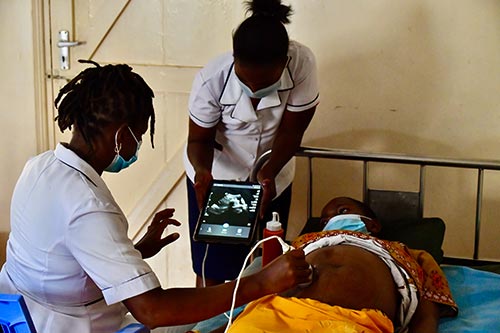News
Midwives bring portable ultrasound technology to remote communities in Kenya
- 15 July 2021
News
MFANGANO ISLAND, Kenya – In her four years at Sena Health Centre, midwife Goretti Adhiambo has seen too many lives lost to complications in pregnancy and childbirth. “We provide all the basic maternal health services at the health centre including antenatal care, but complicated cases have to be referred to the mainland hospital for specialized care,” she explained.
Her health centre is located on the remote Mfangano Island in Kenya’s Homa Bay County. Reaching the mainland town of Mbita for treatment requires at least an hour’s boat ride – two, if the waters are choppy. During an obstetric emergency, this delay can be deadly.
In 2018, Ms. Adhiambo treated a young woman with labour complications. The woman was referred to the mainland for specialized care but died while being ferried to Mbita. “She was barely 18 years old, and to lose such a young life was very painful for my colleagues and me,” Ms. Adhiambo recalled.
Today, Ms. Adhiambo is the midwife in charge, overseeing the care of expectant mothers and newborns. And she has a new tool in her arsenal that can help identify complications long before they become life-threatening: an ultrasound device.
For years, pregnant women on Mfangano Island have had to travel to the mainland not only for emergency obstetric care, but also for diagnostic services as simple as an obstetric ultrasound screening. Such tools are often only available at specialist health facilities located in major towns and urban areas. As a result, pregnancy complications are often only identified at great effort and expense, too late for treatment, or not at all.

But this is starting to change.
Through a partnership between UNFPA, AMREF International University and the Phillips Foundation, portable ultrasound technology – and the training to go with it – are being made available to midwives from far-flung health centres in remote parts of Kenya.
Ms. Adhiambo and others recently learned how to use the portable machine, known as the Lumify Probe, from experienced sonographers who guided them on skills including: confirming whether a pregnancy is viable, visualizing and recognizing the number of fetuses, identifying where in the uterus the placenta is, and detecting the position of a fetus. By being able to spot issues, such as breech position of the fetus or multiple pregnancy, midwives are able to provide better advice, monitoring and referrals.
“When midwives become proficient in providing basic obstetric ultrasound at point of care, early detection of pregnancy complications and timely referral to higher level health facilities can occur,” said Priscilla Ngunju, a project coordinator with AMREF International University. “Our hope is that more mothers are able to access at least one obstetric screen, done before 24 weeks of gestation, in keeping with the World Health Organization recommendations.”
The trained midwives also received Lumify Probe devices for their health facilities. And because the device is portable, the midwives are able to carry it with them when conducting home and community visits, expanding the reach of these critical services.
In addition to eliminating the cost of transport to the mainland, the programme has greatly lowered the cost of ultrasound screenings. Ultrasound screenings at the clinic cost Ksh 500 (about $5), while they can be double or triple the cost at specialist health facilities.
Ms. Adhiambo says she is happy the expectant mothers she serves at Sena Health Centre will be spared these burdens.
“I learned a lot from the training, including how to interpret an ultrasound image, locating the placenta and detection of serious birth defects,” she told UNFPA. “I can now use my skills to save the life of a mother.”